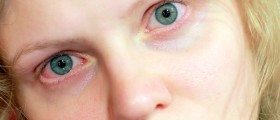
Eye herpes types
Ocular herpes is caused by the same virus that causes all other kinds of herpes, the herpes simplex virus. It is a lot like any other contagious eye infection and it can lead to corneal scarring, cause extreme redness of the eye, pain and inflammation.
Similar to conjunctivitis, it is a viral eye infection and often accompanies a cold sore.
It is contagious and recurrent in nature and will usually cause an inflammation of the eye.
The virus will enter the body through the nose or mouth usually and then remains dormant in the nerves for several days, and sometimes even years, before the eye herpes occurs.
There are many different types of herpes, and it all depends on where the infection is located. There are three kinds of ocular herpes, keratis, stromal and iridocyclitis.
The most common type of eye herpes is keratitis, which occurs near the cornea. It can easily be treated if only the top part of the cornea is infection and this kind of herpes will usually not cause any scarring.
If the infection is deeper, however, there would be some scarring and even a loss of vision and blindness, this is known as stromal keratitis.
When it causes an infection of the iris, then it is iridocyclitis herpes, but, this condition is fairly rare. There will be inflammation and blurry sight in this case.
Causes
There are many factors that can activate the herpes virus once it enters the body. Some include stress, exposure of sunlight, fever, trauma or surgery. It is a contagious disease and it can spread very easily from one person to another and from one infected eye to the other as well.
Usually, it only infects one eye, but there have been cases in which both eyes are infected.
Symptoms
The main symptoms, as previously mentioned, are redness and inflammation of the eyes. The location of the infection will usually determine its severity.
Some of the main and most common symptoms are irritation and pain, inflammation and swelling, redness, tearing, watery and sticky discharge, light sensitivity and blurred vision. Treatments
The location and severity of the infection will determine the proper treatment. If the outer layer of the cornea is only infected, then it will be treated with some type of drops or ointments. Oral antiviral medicine can also be used for people who do not like putting drops or ointment on their eyes and touching them with their fingers.
Steroid drops can also be used to bring down the inflammation, however, they could decrease the immune system’s level of activity, which is a major side effect of such a treatment.
Surgery can be required if the infection is very deep and results in scarring.

















Your thoughts on this
Loading...